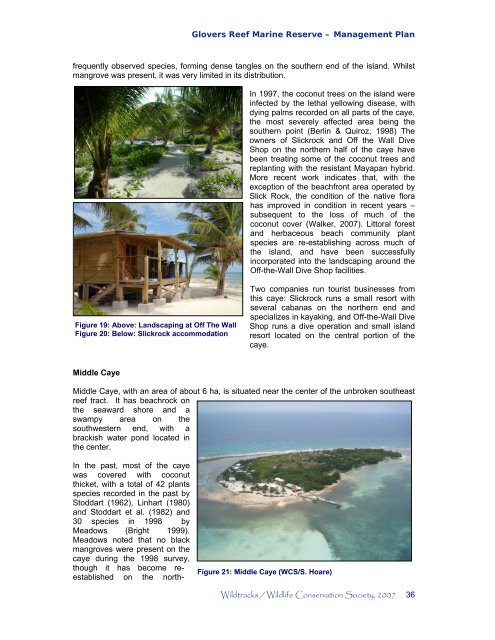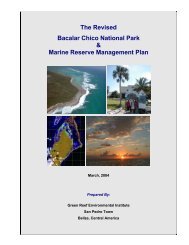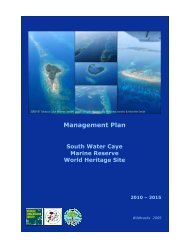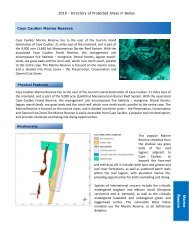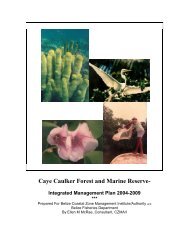Management Plan - Glover's Reef Marine Reserve
Management Plan - Glover's Reef Marine Reserve
Management Plan - Glover's Reef Marine Reserve
You also want an ePaper? Increase the reach of your titles
YUMPU automatically turns print PDFs into web optimized ePapers that Google loves.
Glovers <strong>Reef</strong> <strong>Marine</strong> <strong>Reserve</strong> – <strong>Management</strong> <strong>Plan</strong><br />
frequently observed species, forming dense tangles on the southern end of the island. Whilst<br />
mangrove was present, it was very limited in its distribution.<br />
Figure 19: Above: Landscaping at Off The Wall<br />
Figure 20: Below: Slickrock accommodation<br />
Middle Caye<br />
In 1997, the coconut trees on the island were<br />
infected by the lethal yellowing disease, with<br />
dying palms recorded on all parts of the caye,<br />
the most severely affected area being the<br />
southern point (Berlin & Quiroz, 1998) The<br />
owners of Slickrock and Off the Wall Dive<br />
Shop on the northern half of the caye have<br />
been treating some of the coconut trees and<br />
replanting with the resistant Mayapan hybrid.<br />
More recent work indicates that, with the<br />
exception of the beachfront area operated by<br />
Slick Rock, the condition of the native flora<br />
has improved in condition in recent years –<br />
subsequent to the loss of much of the<br />
coconut cover (Walker, 2007). Littoral forest<br />
and herbaceous beach community plant<br />
species are re-establishing across much of<br />
the island, and have been successfully<br />
incorporated into the landscaping around the<br />
Off-the-Wall Dive Shop facilities.<br />
Two companies run tourist businesses from<br />
this caye: Slickrock runs a small resort with<br />
several cabanas on the northern end and<br />
specializes in kayaking, and Off-the-Wall Dive<br />
Shop runs a dive operation and small island<br />
resort located on the central portion of the<br />
caye.<br />
Middle Caye, with an area of about 6 ha, is situated near the center of the unbroken southeast<br />
reef tract. It has beachrock on<br />
the seaward shore and a<br />
swampy area on the<br />
southwestern end, with a<br />
brackish water pond located in<br />
the center.<br />
In the past, most of the caye<br />
was covered with coconut<br />
thicket, with a total of 42 plants<br />
species recorded in the past by<br />
Stoddart (1962), Linhart (1980)<br />
and Stoddart et al. (1982) and<br />
30 species in 1998 by<br />
Meadows (Bright 1999).<br />
Meadows noted that no black<br />
mangroves were present on the<br />
caye during the 1998 survey,<br />
though it has become reestablished<br />
on the north-<br />
Figure 21: Middle Caye (WCS/S. Hoare)<br />
Wildtracks / Wildlife Conservation Society, 2007 36


